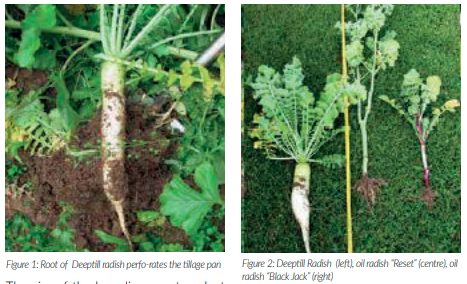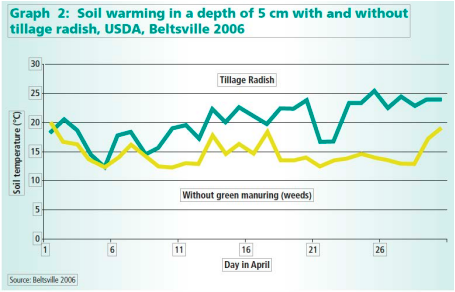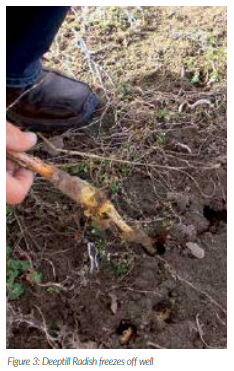Written by Christoph Felgentreu, Deutsche Saatveredelung AG · Bückwitz
Deeptill Radish (Raphanus sativus), also known as “melioration radish” is a plant breeding innovation. The focus was on a strong rooting performance to combat soil compaction during the crucifera selection process.
The aim of the breeding was to select a strong, aggressively downwards growing root. It should have properties similar to those of lupin roots: downwards vertical soil penetration, if possible even through compacted areas, such as tillage pans. This breeding goal has been achieved to a large extent (Figure 1). Today, Deeptill (DT) is also known to offer many other benefits such as a later generative phase, lower winter hardness compared with common oil radish varieties and faster soil warming in spring. The considerably many other benefits such as a later generative phase, lower winter hardness compared with common oil radish varieties and faster soil warming in spring. The considerably cover crop programme “TerraLife”, as its name suggests, places emphasis specifically on good rooting in the soil.
Warming the soil faster
Another advatange of Deeptill radish is its ability to break up soil compaction and open up the soil, allowing the soil to warm up faster in the spring. Experiments by the U.S. Department of Agriculture (USDA) (Graph 2), were able to demonstrate the advantage of faster soil warming by Deeptill radish in spring. It allows the farmer for instance to sow maize earlier without deep cultivation. Deeptill radish will die quicker than other varieties of radishes (Fig. 3). Very shallow tilling or mulching in autumn can help to secure winter kill, particularly in a mild winter.
TerraLife DT
For the new cover crop season, DSV is offering mixes including Deeptill radish. These are marked with the abbreviation “DT”. These mixes are particularly well suited to limy sites, where lupins don’t grow well or possibly not at all, and combining the advantages of the other components in the mix with those of the radish.

The aim of the breeding was to select a strong, aggressively downwards growing root. It should have properties similar to those of lupin roots: downwards vertical soil penetration, if possible even through compacted areas, such as tillage pans. This breeding goal has been achieved to a large extent (Figure 1). Today, Deeptill (DT) is also known to offer many other benefits such as a later generative phase, lower winter hardness compared with common oil radish varieties and faster soil warming in spring. The considerably many other benefits such as a later generative phase, lower winter hardness compared with common oil radish varieties and faster soil warming in spring. The considerably cover crop programme “TerraLife”, as its name suggests, places emphasis specifically on good rooting in the soil.

Warming the soil faster
Another advatange of Deeptill radish is its ability to break up soil compaction and open up the soil, allowing the soil to warm up faster in the spring. Experiments by the U.S. Department of Agriculture (USDA) (Graph 2), were able to demonstrate the advantage of faster soil warming by Deeptill radish in spring. It allows the farmer for instance to sow maize earlier without deep cultivation.

Deeptill radish will die quicker than other varieties of radishes (Fig. 3). Very shallow tilling or mulching in autumn can help to secure winter kill, particularly in a mild winter.
